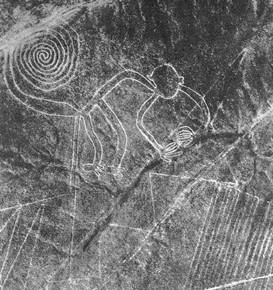| 01/27/12 #236 0m |
He produces remarkable artwork with his GPS data:

There is very little new under the sun (VLNUS); using terrain to create artwork that shows up on maps has been around. Geoglyphs are large designs or motifs produced on the ground, typically formed by rocks or durable elements of the geography, such as stones, stone fragments, gravel, or earth. In a way, PacTom's artwork produces virtual geoglyphs.
The cultural significance of the "legacy" physical geoglyphs for their creators is unclear due to a lack of documentation. The 'Works of the Old Men' in Arabia have been described as geoglyphs. Recently some geoglyphs have been discovered in the Amazon Rainforest, in Brazil, among the Megaliths in the Urals.
 Other areas with geoglyphs include South Australia (Marree Man), Western Australia and parts of the Great Basin Desert in SW United States. Hill figures, turf mazes and the stone-lined labyrinths of Scandinavia, Iceland, Lappland and the former Soviet Union are all types of geoglyph.
Other areas with geoglyphs include South Australia (Marree Man), Western Australia and parts of the Great Basin Desert in SW United States. Hill figures, turf mazes and the stone-lined labyrinths of Scandinavia, Iceland, Lappland and the former Soviet Union are all types of geoglyph.The most famous geoglyphs are the Nazca Lines, a series of ancient geoglyphs located in the Nazca Desert in southern Peru. Scholars believe the Nazca Lines were created by the Nazca culture between 400 and 650 AD. The hundreds of individual figures range in complexity from simple lines to stylized hummingbirds, spiders, monkeys, fish, sharks, orcas, llamas, and lizards.
Although there are as many theories as PhD candidates explaining the meaning and purpose of the geoglyphs, there is no generally accepted understanding. It may be that the puzzle of the Nazca Lines has been solved by a Baltimore bicyclist, who has created virtual geoglyphs.
Baltimore cyclist Michael Wallace uses his bicycle and his GPS to make the streets of Baltimore into his own canvas by planning, riding and tracking creative routes.
For instance, The Jellyfish Invasion by Michael Wallace:
.jpg)
The Hammer by Michael Wallace:
.jpg)
Post 9-11 Tribute to the Manhattan Skyline by Michael Wallace:

Bicyclists do amazing things.
No comments:
Post a Comment